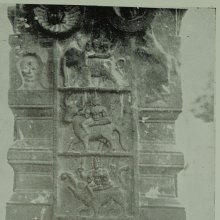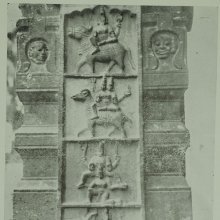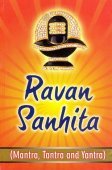Ashtadikpalaka, Ashta-dikpalaka, Aṣṭadikpālaka: 5 definitions
Introduction:
Ashtadikpalaka means something in Hinduism, Sanskrit. If you want to know the exact meaning, history, etymology or English translation of this term then check out the descriptions on this page. Add your comment or reference to a book if you want to contribute to this summary article.
The Sanskrit term Aṣṭadikpālaka can be transliterated into English as Astadikpalaka or Ashtadikpalaka, using the IAST transliteration scheme (?).
Images (photo gallery)
In Hinduism
Vastushastra (architecture)
Source: Shodhganga: Temples of Salem region Up to 1336 ADAṣṭadikpālaka (अष्टदिक्पालक).—The central panel has Śiva as Umāsahita and the surrounding panels have Aṣṭadikpālakas carved in each of the panel. They are carved in their respective directions i.e.
Indra (east),
- Agni (south-east),
- Yama (south),
- Nirṛti (south-West),
- Varuṇa (West),
- Vāyu (North West),
- Kubera (North),
- Īśāna (North East).
They are shown with their consorts and as riding on their vehicles. These vehicles are shown in movement

Vastushastra (वास्तुशास्त्र, vāstuśāstra) refers to the ancient Indian science (shastra) of architecture (vastu), dealing with topics such architecture, sculpture, town-building, fort building and various other constructions. Vastu also deals with the philosophy of the architectural relation with the cosmic universe.
Purana and Itihasa (epic history)
Source: archive.org: Puranic EncyclopediaAṣṭadikpālaka (अष्टदिक्पालक).—The Devī Bhāgavata states like this about the eight zones and their guardians. Situated in the eight different zones of the Brahmaloka are eight big cities of the eight guardians of these zones each covering an area of 2500 yojanas. All these are on the top of Mahāmeru and Brahmā sits in the centre in his city called Manovatī.
Around his city are the others as follows (Aṣṭama Skandha, Devī Bhāgavata).:
- On the east is Amarāvatī, city of Indra.
- On South-east is Tejovatī, city of Agni.
- On the South is Saṃyamanī, city of Yama.
- On the South-west is Kṛṣṇāñjanā, city of Nirṛti.
- On the West is Śraddhāvatī, city of Varuṇa.
- On the North-west is Gandhavatī, city of Vāyu.
- On the North is Mahodaya, city of Kubera.
- On the North-east is Yaśovatī, city of Śiva.

The Purana (पुराण, purāṇas) refers to Sanskrit literature preserving ancient India’s vast cultural history, including historical legends, religious ceremonies, various arts and sciences. The eighteen mahapuranas total over 400,000 shlokas (metrical couplets) and date to at least several centuries BCE.
Shilpashastra (iconography)
Source: Shodhganga: The significance of the mūla-beras (śilpa)Aṣṭadikpālaka (अष्टदिक्पालक) or Aṣṭadikpāla refers to the “eight guardians of the directions”, as defined according to texts dealing with śilpa (arts and crafs), known as śilpaśāstras.—The hand poses for the eight dikpālas (guardians of directions) are described in the Abhinayadarpaṇa and they are followed in the dance performance. But the hastas prescribed to depict the [Aṣṭadikpālaka] Gods in Abhinayadarpaṇa do not exactly look like the images of Gods found in the temples.
Indra is represented with two kartarīmukha-hastas holding the vajra in the left hand and a flower in the right hand. Agni is found with four hands where the upper hands hold a torch in kartarīmukha hastas and the lower hands hold a porringer in kuvi-patāka-hasta. Yama is found holding a club in his left hand near the left shoulder and in the right hand holding the rope of the buffalo on which he rides. Nirti is found with the right hand holding the club and the left hand hanging loose. Varuna is found holding pāśa in both his hands in kaṭaka or siṃha-karna-hasta. The figure of Vāyu chiseled is found in kartarīmukha-hasta.Yakṣapatī (Kubera) is found with a sword in the right hand and a shield in the left hand. Īśāna is found with a trident and a drum in the right and the left hands respectively.
The hastas used in dance for all the aṣṭadikpālaka are not exactly the same as the hastas found in the respective aṣṭadikpālaka. In a few cases there are similarities and in a few other cases there are dissimilarities as well. In choreography and performance, the dancer uses the hastas prescribed in the traditional texts as well he/she uses the hand gestures taught by the Gurus. But if the dancer can bring into practice the usage of the mudrās of the respective deities, then it would enhance the quality of the dancing as well as would bring out the depth of knowledge the dancer has on the deities.

Shilpashastra (शिल्पशास्त्र, śilpaśāstra) represents the ancient Indian science (shastra) of creative arts (shilpa) such as sculpture, iconography and painting. Closely related to Vastushastra (architecture), they often share the same literature.
General definition (in Hinduism)
Source: Google Books: Genealogy of the South Indian DeitiesAṣṭadikpālakas are the guardians of the eight [cardinal] points of the world. Their names are as follows:
- Indra is the above-mentioned king gods. He is also known as Devendra.
- Agni is the element fire, more precisely the gods of fire, also known as Agnibhagavān.
- Yama is the god of death and king of hell or the lowest world that is known as Pātālaloka and Yamaloka.
- Nirṛti is the element earth and is portrayed in the form of a giant.
- Vāyu is the element air, more precisely the god of air.
- Varuṇa is the god of clouds and rain.
- Kubera is the god of riches.
- Īśāna is Īśvara himself.
All these [guardians] are worshipped on festival days and whenever sacrifices are offered, especially when the burnt offerings known as Yāga, Homa and Yajana are made.
Languages of India and abroad
Kannada-English dictionary
Source: Alar: Kannada-English corpusAṣṭadikpālaka (ಅಷ್ಟದಿಕ್ಪಾಲಕ):—[noun] = ಅಷ್ಟದಿಕ್ಪಾಲ [ashtadikpala].
Kannada is a Dravidian language (as opposed to the Indo-European language family) mainly spoken in the southwestern region of India.
See also (Relevant definitions)
Partial matches: Ashta, Dikpalaka.
Full-text: Lokapala, Shraddhavati, Dikpalaka, Dikpala, Ashtadikpala, Manovati, Varuna, Tittibhasaras, Nriti, Kubera, Yakshapati, Amaravati, Parivaradevata, Ishana, Vayu, Indra, Agni, Yama.
Relevant text
Search found 1 books and stories containing Ashtadikpalaka, Ashta-dikpalaka, Aṣṭadikpālaka, Aṣṭa-dikpālaka, Asta-dikpalaka, Astadikpalaka, Aṣtadikpālaka; (plurals include: Ashtadikpalakas, dikpalakas, Aṣṭadikpālakas, dikpālakas, Astadikpalakas, Aṣtadikpālakas). You can also click to the full overview containing English textual excerpts. Below are direct links for the most relevant articles:
Related products


